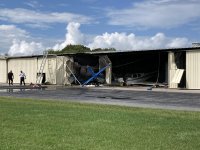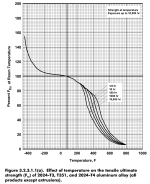Ed_Wischmeyer
Well Known Member
On Sunday, a Cessna 182 two hangars over caught fire and was completely consumed, as were several other airplanes. The Grumman Cheetah in the hangar between the Cessna and me had a melted headliner, warped dorsal fin, and other things. Initial reports were that my plane was covered with heavy soot, no obvious damage, but no other details were available.
Yesterday, the FBO called and told me that my plane was out of the hangar, a big relief as it seemed unlikely that power would be on again soon, if ever, to get the bifold door open. They were to tow the plane to another hangar in advance of Hurricane Idalia, which is expected to weaken to a tropical storm before it gets here after crossing Florida. A friend took photos, showing where plastic ceiling light fixtures had dripped onto the plane, including the canopy.
Yesterday, I coordinated with the insurance adjuster, my homeowner’s insurance agent, the FBO, and my friends who volunteered to help me get things out of the hangar. With the plane out of the hangar, I asked the airplane detailing crew to hose off the plane, nothing fancy, but enough that we could see any damage.
The pessimistic, always prepared part of me was thinking of alternative courses of action if the canopy needed replacing, the paint was damaged, or if any sheet metal had been damaged by molten light fixtures,
This afternoon, the insurance adjuster arrived, and I got my first look at the plane. All of the molten light fixture was washed off, but paint was discolored where the drips had been. There was no evidence of same on the canopy, a good sign, but I’ve never been good at examining my own planes, although I’m sharp at examining others’.
The adjuster walked around the plane taking picture, four quarter shots first, then detail shots, just as is taught in accident investigations courses. Then came numerous detail shots, including close examination of the data plate. He took photos of the logbooks over the last four years.
Then I opened the canopy. Yikes! There was soot everywhere. You know, like, everywhere. I knew from flying in rain that the back of the canopy doesn’t seal well, and the soot discovered that for itself. I have a shelf behind the seats of the RV-9A, a tremendously valuable improvement, and objects on the shelf showed that the biggest air leak is directly behind the pilot.
We removed the soot-covered plastic containers from the shelf, the soot-covered oxygen bottle from the shelf, the soot-covered portable electronics from above the instrument panel, the soot -covered headphones, and, can you believe it, the soot-covered tool box from the baggage compartment, next to the soot-covered spare alternator box. You get the idea. What a mess!
Next steps are to get the plane detailed and get all (ha!) the soot out of the plane and the interior, getting it ready for a first inspection by the mechanics. Hopefully it will be airworthy enough for one or two long-since planned trips. If not, there will be painful drives to Florida.
The adjuster says that soot-induced corrosion takes 30 days to show up and recommended a very detailed inspection at that time. Although it’s only been six months since the last [annual] condition inspection, and since the plane will be that much apart already, it seems like a good idea to do the condition inspection early.
Actual damage to my RV-9A was to the fiberglass nav light cover on the left wingtip, which warped, and numerous paint discolorations from the hot plastic of the ceiling light fixtures. Those spots will be rubbed out or touched up, And there was soot all over everything in the hangar, too. Did I mention soot?
It looks like the hangar object soot will resist being blown off, and I will research having the soot removal hired out.
But I’m grateful for support and volunteerism from friends, for all that the RV-9A has enabled me to do, to learn, and to write about, and for the many blessings the Lord has given me to share.
Yesterday, the FBO called and told me that my plane was out of the hangar, a big relief as it seemed unlikely that power would be on again soon, if ever, to get the bifold door open. They were to tow the plane to another hangar in advance of Hurricane Idalia, which is expected to weaken to a tropical storm before it gets here after crossing Florida. A friend took photos, showing where plastic ceiling light fixtures had dripped onto the plane, including the canopy.
Yesterday, I coordinated with the insurance adjuster, my homeowner’s insurance agent, the FBO, and my friends who volunteered to help me get things out of the hangar. With the plane out of the hangar, I asked the airplane detailing crew to hose off the plane, nothing fancy, but enough that we could see any damage.
The pessimistic, always prepared part of me was thinking of alternative courses of action if the canopy needed replacing, the paint was damaged, or if any sheet metal had been damaged by molten light fixtures,
This afternoon, the insurance adjuster arrived, and I got my first look at the plane. All of the molten light fixture was washed off, but paint was discolored where the drips had been. There was no evidence of same on the canopy, a good sign, but I’ve never been good at examining my own planes, although I’m sharp at examining others’.
The adjuster walked around the plane taking picture, four quarter shots first, then detail shots, just as is taught in accident investigations courses. Then came numerous detail shots, including close examination of the data plate. He took photos of the logbooks over the last four years.
Then I opened the canopy. Yikes! There was soot everywhere. You know, like, everywhere. I knew from flying in rain that the back of the canopy doesn’t seal well, and the soot discovered that for itself. I have a shelf behind the seats of the RV-9A, a tremendously valuable improvement, and objects on the shelf showed that the biggest air leak is directly behind the pilot.
We removed the soot-covered plastic containers from the shelf, the soot-covered oxygen bottle from the shelf, the soot-covered portable electronics from above the instrument panel, the soot -covered headphones, and, can you believe it, the soot-covered tool box from the baggage compartment, next to the soot-covered spare alternator box. You get the idea. What a mess!
Next steps are to get the plane detailed and get all (ha!) the soot out of the plane and the interior, getting it ready for a first inspection by the mechanics. Hopefully it will be airworthy enough for one or two long-since planned trips. If not, there will be painful drives to Florida.
The adjuster says that soot-induced corrosion takes 30 days to show up and recommended a very detailed inspection at that time. Although it’s only been six months since the last [annual] condition inspection, and since the plane will be that much apart already, it seems like a good idea to do the condition inspection early.
Actual damage to my RV-9A was to the fiberglass nav light cover on the left wingtip, which warped, and numerous paint discolorations from the hot plastic of the ceiling light fixtures. Those spots will be rubbed out or touched up, And there was soot all over everything in the hangar, too. Did I mention soot?
It looks like the hangar object soot will resist being blown off, and I will research having the soot removal hired out.
But I’m grateful for support and volunteerism from friends, for all that the RV-9A has enabled me to do, to learn, and to write about, and for the many blessings the Lord has given me to share.






